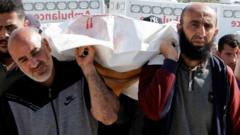As the Gaza war continues, the Hamas-run health ministry claims over 51,200 Palestinians have died, sparking debate over the reliability of these statistics as Israel questions their accuracy. While health officials assert a focus on credible data, discrepancies in casualty lists have been scrutinized, prompting discussions on how deaths are reported and the challenges posed by the chaotic environment of war.
Gaza's Health Ministry Addresses Controversy Over Death Toll Figures Amid Ongoing Conflict

Gaza's Health Ministry Addresses Controversy Over Death Toll Figures Amid Ongoing Conflict
The Hamas-run health ministry in Gaza defends its statistics amidst accusations from Israel regarding the accuracy of death toll figures during the prolonged conflict.
In Gaza City, the scenes are heart-wrenching. Alam Hirzallah sits in al-Shifa Hospital, grappling with the deaths of his cousin’s family—his wife and two young children, victims of Israeli shelling. With a grim resolve, he submits the necessary paperwork, attempting to navigate the bureaucratic labyrinth of a war-torn region where burial sites are under Israeli control. The health ministry, led by Hamas, reports over 51,266 deaths, approximately a third of whom are children, since the outbreak of conflict 18 months ago.
Israel contends that these figures are inflated, a claim that has fueled accusations of manipulation for propaganda purposes. Reports indicate a revision in casualty lists, with around 3,000 names removed from the official count. Gazan health official Zaher al-Wahidi insists the process is one of verification rather than deletion, emphasizing efforts for accurate reporting.
The methodology for collecting statistics in Gaza has evolved amid rising chaos. Initially based on body counts brought to hospitals, the verification process has shifted to online reporting forms for relatives of the deceased, leading to inconsistencies as names are periodically updated or removed pending investigation. Al-Wahidi asserts that names taken off may be reinstated once verified, underlining the importance of credibility in the chaotic environment of war.
Critics, particularly those aligned with Israeli perspectives, assert those discrepancies underscore deliberate manipulation. However, independent observers suggest these may be part of an extensive effort to clarify casualty numbers. The ongoing conflict has complicated accurate data collection, especially given the high stakes involved in proceeds for mapping fatalities.
Amidst the destruction, many casualties remain unidentified, as thousands lie buried under rubble, unregistered. Gazan health officials have embarked on recovery missions to identify and account for human remains amidst the chaos, while Israel claims significant numbers of combatants have been killed, though civilian death tolls remain unconfirmed.
The conflict began on October 7, 2023, and has since engulfed both Israel and Palestine in a cycle of violence, leading to unprecedented casualty figures. The future of the war remains uncertain, with journalists' access to Gaza severely limited, leaving room for speculation and debate on the realities of the tragic human toll.
Israel contends that these figures are inflated, a claim that has fueled accusations of manipulation for propaganda purposes. Reports indicate a revision in casualty lists, with around 3,000 names removed from the official count. Gazan health official Zaher al-Wahidi insists the process is one of verification rather than deletion, emphasizing efforts for accurate reporting.
The methodology for collecting statistics in Gaza has evolved amid rising chaos. Initially based on body counts brought to hospitals, the verification process has shifted to online reporting forms for relatives of the deceased, leading to inconsistencies as names are periodically updated or removed pending investigation. Al-Wahidi asserts that names taken off may be reinstated once verified, underlining the importance of credibility in the chaotic environment of war.
Critics, particularly those aligned with Israeli perspectives, assert those discrepancies underscore deliberate manipulation. However, independent observers suggest these may be part of an extensive effort to clarify casualty numbers. The ongoing conflict has complicated accurate data collection, especially given the high stakes involved in proceeds for mapping fatalities.
Amidst the destruction, many casualties remain unidentified, as thousands lie buried under rubble, unregistered. Gazan health officials have embarked on recovery missions to identify and account for human remains amidst the chaos, while Israel claims significant numbers of combatants have been killed, though civilian death tolls remain unconfirmed.
The conflict began on October 7, 2023, and has since engulfed both Israel and Palestine in a cycle of violence, leading to unprecedented casualty figures. The future of the war remains uncertain, with journalists' access to Gaza severely limited, leaving room for speculation and debate on the realities of the tragic human toll.






















